The Margaret Cheney Room - 1916 to the Present
Introduction
Text-to-speech Audio
The Margaret Cheney Reading Room has played an essential role in the history of women students at MIT. When it first opened on the Boston campus in 1884, the Cheney Room provided the facilities that guaranteed women a place at MIT. Over multiple moves and renovations, the Cheney Room continues to evolve to meet the needs of MIT’s women students.
Today's Margaret Cheney Room suite, located at 3-308 and 3-310, provides a physically and emotionally safe environment for women or women-identifying students. Private space: Key card access required.
Images
The Margaret Cheney Room (Note picture of Margaret Cheney above Bookcase), Building 10,1921
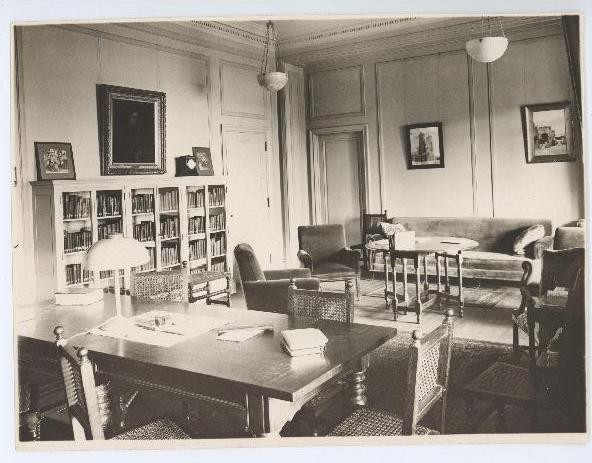
Margaret Cheney Room, Building 10, 1935
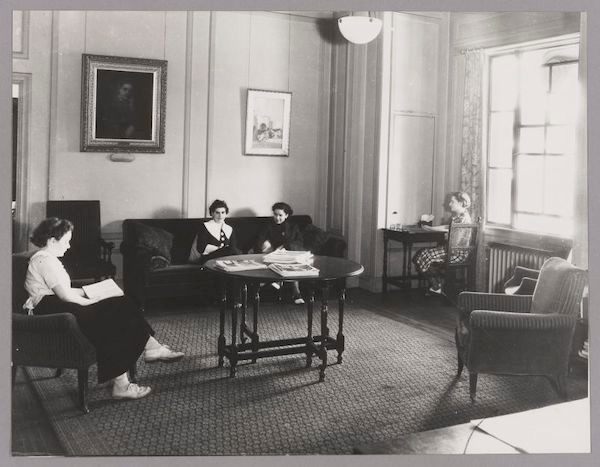
Margaret Cheney Room Doorway, Circa 1939 or later.
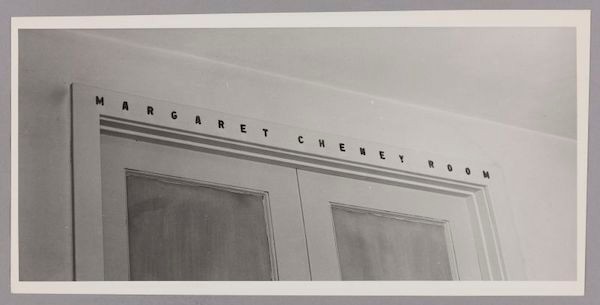
Cheney Room, Building 3, March 1940.
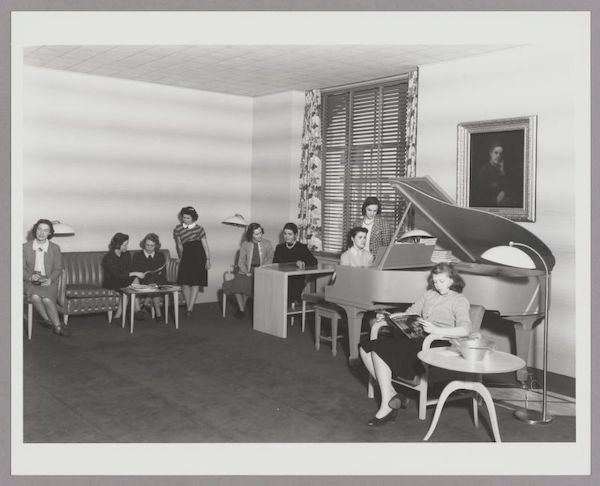
Photo Stills from the Social Beaver, Builing 3, 1956.
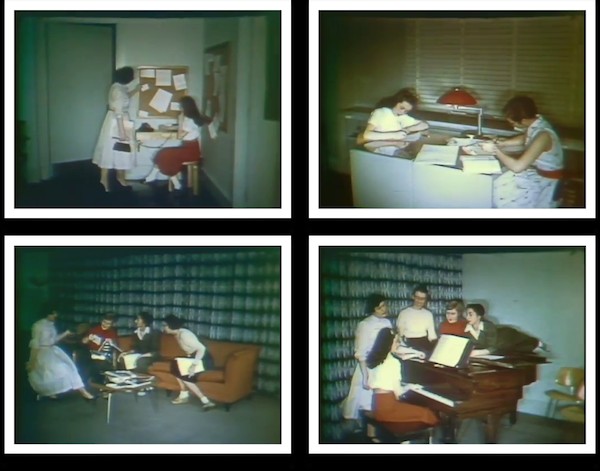
Pre-Renovation 2022: During the renovation, Margaret's portrait was removed and stored by the MIT Museum. Building 3, June 2022)
.jpg)
From Top: Kitchen, Quiet/Lactation Room, Staging artwork. Building 3, December 2022.
_Sircar.jpg)
Meeting & gathering spaces, Building 3, January 2023.
_Lauyrn_McNair.jpg)
Photographs of a framed painting of Margaret Swan Cheney, painted by George Fuller in 1884

Backstory and Context
Text-to-speech Audio
The Cheney Room first opened in 1884 in MIT’s newly built Walker Building in Boston. In 1898, the Walker Building underwent substantial renovation to increase laboratory space, forcing the Cheney Room to move to the Pierce Building. When MIT moved to Cambridge in 1916, the Cheney Room moved once again, this time occupying a central place on campus in Building 10 overlooking the Great Court.[1]
The new Cheney Room was freshly furnished with funds from the Ednah Dow Cheney fund, the MIT Women’s Association, and donations from its members. Although slightly smaller than the previous Cheney Room, the new space had a larger kitchenette, essential for women students who lived far from campus.[2]
At a time when women students made up only about one percent of the student population, the Cheney Room was an essential center for women on campus. The undergraduate women’s society, Cleofan, held meetings and social events in the Cheney Room that were open to all women students.[2]
Although women students continued to make up only a small minority of MIT’s student body, the population of female students had grown significantly to approximately 50 students by the late 1930s. In 1937, MIT President Karl T. Compton appointed Florence W. Stiles(1922 S.B. Architecture) advisor to female students and tasked her with studying the needs of women students and organizations at MIT.[4] It was clear that the Cheney Room was an essential space, but was too small to meet needs of the growing women student population.
In 1939, the Cheney Room moved to the third floor of Building 3 in the newly expanded Rogers Building. Florence, who had worked as a librarian at the Rotch Library for Architecture since 1931, designed the new, larger Cheney Room to better serve the needs of women students. Based on recommendations from a committee of alumnae, women students, and faculty wives, Florence’s design included a lounge, study room, kitchen, and locker room. Leona Zarsky (1941 S.B. Physical Biology) who witnessed the Cheney Room transformation while a student at MIT, described the new Cheney Room as a “warm and friendly” place “where we could go and leave our coat and hat and walk back and forth and aggravate before exams."[5]
Although female enrollment slowly increased during the 1940s and 1950s, women remained only a small minority of the student population and continued to face considerable pushback from the male majority.[6] The Cheney Room played an essential role in campus life as the only space dedicated to women students. In 1945, MIT opened its first women’s dormitory in Boston, however, its limited size and distance from the Cambridge campus limited its role as a social center. The welcoming walls of the Cheney Room remained as important as ever to MIT’s women. Theresa Urhich Adams, (1949 S.B. Aeronautics & Astronautics), who attended MIT at a time when female students averaged 66 students a year, or about five percent of the total student population, reflected that “the Margaret Cheney Room was a very nice place to go and escape, rather than the library. There were not that many women students, so we got to know each other there. Most of them were graduate students."[7] Emily Wick (1951 Ph.D. Chemistry) remembers the Cheney Room as “our haven.”[8]
The Cheney Room gave the women of MIT a space of their own; it was a place where women students could share meals, socialize, relax, and, in typical MIT fashion, nap while monitoring late night experiments.[9] Most importantly, the Cheney Room was a place for women students to build a community and support one another. Margolia Cohen Gilson (1956 S.B Biology), describes the Cheney Room and the significant role it played in the lives of women students: “there was a large kitchen area and a big living room area with a lovely grand piano. Some of the girls were very talented. Not me. And we had a place for our lockers and for our books in the lockers. We had a very nice suite of rooms there, and the study room had a collection of what they called bibles. They were the old notes from previous people who would have taken the basic courses. We used those as a guide for our studying. There were about three or four desks in there, and the girls helped each other."[10]
In 1963, the opening of McCormick Hall ushered in a new era for women students at MIT. For some, the investment in a women’s dormitory on campus was a vote of confidence in a place for women at MIT. One year later, in 1964, the number of women applying to MIT increased by fifty percent.[6]
As the number of women students continued to rise during the 1960s, so too did their desire to secure an equal place for women in a male-dominated world. Inspired by growing women’s movements across the country, MIT’s women organized to fight against the hostility and discrimination they faced daily.
Not surprisingly, the Cheney Room once again bore witness to the increased presence and voices of MIT’s women. During the second annual Independent Activities Period in January of 1972, Professor Emily Wick and Professor Mildred Dresselhaus held a seminar on the status of women at MIT. About one hundred female students, faculty, staff, postdocs, alumni, and faculty wives gathered in the Cheney Room for the seminar, which would later become the MIT Women’s Forum. The MIT Women’s Forum advocated for gender awareness and was instrumental in reshaping the role of women at MIT by creating an ad hoc committee to review the environment for women at MIT and advocating for the appointment of a special assistant to the president and chancellor for women and work.[13]
The Cheney Room continued to be a center for activism throughout the 1970s and 1980s. Described as a “hotbed of feminist activity”, the Cheney Room held weekly meetings with speakers addressing important issues, including violence against women, lesbianism, and the politics of women’s biology.[9]
During the early 2000s and 2010s, the Cheney Room played a quieter role in the lives of women students, often providing a private place for students to study, relax, or socialize. In 2023, the Cheney room reopened after significant renovations, which were largely shaped by input from current students. Painted in new warmer colors and adorned with artwork created by women and non-binary indie artists, the newly renovated Cheney room includes a larger lounge, a lactation and wellness room, a conference room, and an expanded kitchen area.[15]
Under the caring eye of Margaret, whose portrait is still on display after 140 years, the Margaret Cheney Reading Room continues to be an important space for women and women-identifying students at MIT, who now make up over 45 percent of the student body.
Cite This Entry
Sarah Winston on behalf of Association of MIT Alumnae (AMITA) and Coleen Smith. "The Margaret Cheney Room - 1916 to the Present." Clio: Your Guide to History. September 27, 2023. Accessed April 11, 2025. https://theclio.com/entry/147658
Sources
[1] Lloyd, Maggie. “The Cheney Room: MIT’s hidden gem.” The Tech. 10 December 2010. https://thetech.com/2010/12/10/cheney-v130-n60. 20 May 2023.
[2] Sawyer, Mrs. Charles Winthrop and Minns, Miss Susan. “History Of The Margaret Cheney Reading Room.” Technology Review, No. 23, MIT Alumni Association, 1921.https://archive.org/details/MIT-Technology-Review-1921-11/page/n31/mode/2up. Accessed 27 Sep. 2023.
[4] “M.I.T. Names Women’s Guide. Miss Florence Stiles First to Hold Post of Adviser at The Institute.” The New York Times. 30 April 1939. https://www.nytimes.com/1939/04/30/archives/mit-names-womens-guide-miss-florence-stiles-first-to-hold-post-of.html Accessed. 20 April 2023.
[5] Zarsky, Leona. “AMITA-MacVicar Oral History Project: Leona Zarsky, Class of 1941.” Interview by Rellen Hardke. 1991. Interviews of the Margaret MacVicar Memorial AMITA Oral History Project. https://dome.mit.edu/bitstream/handle/1721.3/74333/MC0356_168005.pdf
[6] Bix. Amy Sue. “Feminism where men predominate: The history of women's science and engineering education at MIT.” Women's Studies Quarterly; Old Westbury, N.Y. Vol. 28, Iss. 1, Spring 2000.
[7] Adams, Theresa Urhich. “AMITA-MacVicar Oral History Project Theresa Urhich Adams, Class of 1949.” Interview by Margo Harbaugh. 1996. Interviews of the Margaret MacVicar Memorial AMITA Oral History Project. https://dome.mit.edu/bitstream/handle/1721.3/74334/MC0356_683134.pdf Accessed 20 May 2023.
[8] Wick, Emily. “AMITA-MacVicar Oral History Project Emily Wick, Class of 1951.” Interviewed by Dawn Herzbrun. 1992. Interviews of the Margaret MacVicar Memorial AMITA Oral History Project. https://dome.mit.edu/bitstream/handle/1721.3/74359/MC0356_353914.pdf Accessed 20 May 2023.
[9] Atwood, Sally. “A Haven for Women: One Alumna’s Legacy.” MIT Technology Review. 1 September 2005. https://www.technologyreview.com/2005/09/01/230395/a-haven-for-women-one-alumnas-legacy/
[10] Gilson, Margolia Cohen. “AMITA-MacVicar Oral History Project Margolia Cohen Gilson, Class of 1956” Interview by Madeleine Kilne. 2019. Interviews of the Margaret MacVicar Memorial AMITA Oral History Project. https://dome.mit.edu/bitstream/handle/1721.3/189242/MC0356_GilsonM_2019.pdf?sequence=1&isAllowed=y. Accessed 20 May 2023.
[13] “The MIT Women’s Forum.” WIM News. 14 January 2022. https://math.mit.edu/wim/2022/01/14/the-mit-womens-forum/ Accessed 20 May 2023.
[15] “Margaret Cheney Room Renovations.” AMITA Association of MIT Alumnae. https://amita.alumcommunity.mit.edu/news/695239. Accessed 27 Sep. 2023.
1. 1921: Courtesy of the MIT Museum. https://mitmuseum.mit.edu/collections/object/GCP-00059412. Accessed 23 May 2023.
2. 1935: Courtesy of the MIT Museum. https://mitmuseum.mit.edu/collections/object/GCP-00059420. Accessed 23 May 2023.
3. 1939: Courtesy of the MIT Museum. https://mitmuseum.mit.edu/collections/object/GCP-00059415. Accessed 23 May 2023.
4. 1940: Courtesy of the MIT Museum. https://mitmuseum.mit.edu/collections/object/GCP-00059421. Accessed 23 May 2023.
5. Photos Courtesy of MIT Infinite History & the MIT Museum
6. June 2022: Photos by Lauryn McNair & Nayaab Kazmi, 2022
7. December 2022. Photos by Monica Sircar, 2022.
8. January 2023. Photos by Lauryn McNair 2023
Margaret Swan Cheney. Photo by Nayaab Kazmi, 2022

